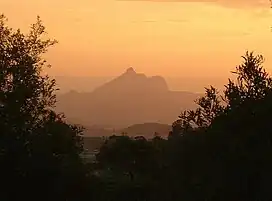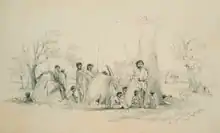Bundjalung people
The Bundjalung people, also spelled Bunjalung, Badjalang and Bandjalang, are Aboriginal Australians who are the original custodians of a region based roughly around the northern coastal area of New South Wales, and a portion of south-east Queensland, with the region stretching as far north as Beaudesert, and stretching south to around Grafton. The region is located approximately 550 kilometres (340 mi) northeast of Sydney, and 100 kilometres (62 mi) south of Brisbane, a large area that includes the Bundjalung National Park.
| Bundjalung people | |
|---|---|
| Aka: Badjalang (Tindale)(Horton) Bandjalang (SIL) | |
 South Eastern Queensland bioregion | |
| Hierarchy | |
| Language family: | Pama–Nyungan |
| Language branch: | Bandjalangic |
| Language group: | Bundjalung |
| Group dialects: | |
| Area (approx. 6,000 sq. km) | |
| Location: |
|
| Coordinates: | 29°15′S 152°55′E |
| Mountains: |
|
| Rivers[4] | Lower reaches of
|
| Other geological: | Cape Byron |
| Urban areas:[4] | |
Bundjalung people all share descent from ancestors who once spoke as their first, preferred language one or more of the dialects of the Lower-Richmond branch of the Yugambeh-Bundjalung language family.
The Arakwal of Byron Bay count themselves as one of the Bundjalung peoples.[1]
Language
Bundjalung is a Pama-Nyungan language. It has two unusual features: certain syllables are strongly stressed while others are "slurred", and it classifies gender into four classes: (a) masculine (b) feminine (c) arboreal and (d) neuter.[6]
Country

According to Norman Tindale, Bundjalung tribal lands encompassed roughly 2,300 square miles (6,000 km2), from the northern side of the Clarence River to the Richmond River, including Ballina with their inland extension running to Tabulam and Baryugil. The coastal Widje clan ventured no further than Rappville.[4]
Alternative names

According to Norman Tindale, various spellings and other names were used for the Bundjalung people:[4]
- Badjelang (paidjal/badjal means "man")
- Bandjalang, Bandjalong
- Budulung
- Buggul
- Bundela, Bundel
- Bunjellung
- Paikalyung, Paikalyug
- Watchee
- Widje (clan or clans at Evans Head)
- Woomargou
Culture
Initiation ceremony
According to R. H. Mathews, the Bundjalung rite of transition into manhood began with a cleared space called a walloonggurra some distance from the main camp. On the evening the novices are taken from their mothers around dusk, the men sing their way to this bora ground where a small bullroarer (dhalguñgwn) is whirled.[7]
Musical instruments
The Bundjalung used a variety of instruments, including blowing on a eucalyptus leaf, creating a bird-like sound. Clapsticks were used to establish a drumbeat rhythm on ceremonial dancing occasions. Emu callers (short didgeridoos about 30 centimetres (12 in) long) were traditionally used by the Bundjalung when hunting (Eastern Australia Coastal Emus). When striking the emu-caller at one end with the open palm it sounds like an emu. This decoy attracts the bird out of the bush making it an easy prey.
Native title
In late April 2021, the Federal Court of Australia convened at Evans Head, where a native title determination was made over 7.2 square kilometres (2.8 sq mi) of land, consisting of 52 separate areas of land. The application had been launched in 1996, and the first determination made in 2013. Included in the land is a bora ring of great cultural significance near Coraki.[8]
Notable people
- Troy Cassar-Daley, country singer, winner of ARIA and Deadly awards, among others[9]
- Melissa Lucashenko, author, winner of 2013 Walkley Award for non-fiction and 2019 Miles Franklin Award
- Sharlene Allsopp,[10] author and poet, winner The Ford Memorial Prize, 2021
- Madeleine and Miah Madden, actresses, half-sisters with Bundjalung heritage through their father
- Lambert McBride, activist for Aboriginal citizenship rights during the 1960s
- Digby Moran, artist[11]
- Nikita Ridgeway, tattoo artist and graphic designer
- Rhoda Roberts, journalist, arts advisor and artistic director
- Anthony Mundine, former boxer, rugby league star
- Evelyn Araluen, poet, researcher, co-editor
- Mark Olive, Aboriginal Australian chef
See also
Notes
Citations
- Bunjalung of Byron Bay 2001.
- Sharpe 1994.
- Bandjalang at Ethnologue (25th ed., 2022)

- Tindale 1974, p. 191.
- Hoff 2006.
- Sharpe 1993, p. 76.
- Mathews 1900, pp. 67–73, 67.
- Ross 2021.
- TC-D.
- "Sharlene Allsopp". Sharlene Allsopp. Retrieved 15 January 2023.
- Farrow-Smith 2020.
Sources
- "About". Troy Cassar-Daley. Retrieved 21 November 2021.
- "ATNS - Agreements, Treaties and Negotiated Settlements project". Agreements, Treaties and Negotiated Settlements (ATNS) project. Retrieved 14 May 2015.
- Bundock, M. (1889). "Note on the aborigines of Casino, N.S.W". Archiv für Ethnologie. 2: 52–53 – via Internet Archive.
- "Bunjalung of Byron Bay (Arakwal) Indigenous Land Use Agreement". Agreements, Treaties and Negotiated Settlements (ATNS) project. 28 August 2001. Archived from the original on 29 February 2020. Retrieved 20 May 2008.
- Farrow-Smith, Eloise (14 January 2020). "Digby Moran, internationally acclaimed First Nations artist, dies". ABC News. Retrieved 15 January 2020.
- "Githabul People's native title determination: North-eastern New South Wales" (PDF). National Native Title Tribunal. 29 November 2007. Archived from the original (PDF) on 1 June 2011.
- Hoff, Jennifer (2006). Bunjalung Jugun [Bunjalung Country]. Richmond River Historical Society. ISBN 1-875474-24-2. citing Yamba Yesterday, Howland and Lee, Yamba Centenary Committee.
- Langford Ginibi, Ruby (15 November 1995). "Australian Biography: Ruby Langford Ginibi" (Interview). Interviewed by Robin Hughes. National Film and Sound Archive.
- Mathews, R. H. (1897a). "Totemic divisions of the Australian tribes". Proceedings of Royal Society of New South Wales. 31: 154–176 – via BHL.
- Mathews, R. H. (1897b). "Wandarral of the Richmond and Clarence River tribes". Proceedings of the Royal Society of Victoria. 10: 29–42 – via BHL.
- Mathews, R. H. (1898). "Initiation ceremonies of Australian tribes. Appendix Nguttan initiation ceremony". Proceedings of the American Philosophical Society. 37: 54–73 – via BHL.
- Mathews, R. H. (1900). "Walloonggurra ceremony" (PDF). Queensland Geographical Journal. 15: 67–74 – via Internet Archive.
- Ross, Hannah (30 April 2021). "NSW Bandjalang people victorious after 25-year native title fight". ABC News. Retrieved 7 May 2021.
- Sharpe, Margaret C. (1985). "Bundjalung Settlement and Migration" (PDF). Aboriginal History. 9 (1): 101–124.
- Sharpe, Margaret C. (1993). "Bunjalung: Teaching a Disappearing Language". In Walsh, Michael; Yallop, Colin (eds.). Language and Culture in Aboriginal Australia. Aboriginal Studies Press. ISBN 978-0-855-75241-5.
- Sharpe, Margaret C. (1994). An all-dialect dictionary of Banjalang, an Australian language no longer in general use. Linguistic Society of the Philippines Special Monograph Issue. pp. 35–48.
- Steele, John Gladstone (1984). Aboriginal Pathways: in Southeast Queensland and the Richmond River. University of Queensland Press. ISBN 978-0-702-25742-1.
- Threlkeld, Lancelot; Fraser, John (1892). An Australian language as spoken by the Awabakal (PDF). Sydney: Government printer.
- Tindale, Norman Barnett (1974). "Badjalang (QLD)". Aboriginal Tribes of Australia: Their Terrain, Environmental Controls, Distribution, Limits, and Proper Names. Australian National University Press.
- "Troy Cassar-Daley". Talking Heads. Australian Broadcasting Corporation. 4 May 2009. Archived from the original on 18 October 2010. Retrieved 12 July 2011.
External links
- Bundjalung of Byron Bay Aboriginal Corporation, representing the Bundjalung and Arakwal people, land and waters
- Bibliography of Bundjalung language and people resources, at the Australian Institute of Aboriginal and Torres Strait Islander Studies
- "Australia's Sacred Sites Part 5 - Byron Bay" ABC Radio's Spirit of Things (October 2002; Retrieved 21 May 2008
- A Walk in the Park Series: "New South Wales - Arakwal National Park" ABC Radio (December 2004) Retrieved 21 May 2008
- "Badjalang" AusAnthrop Australian Aboriginal tribal database. Retrieved 20 May 2008
- Bunjalung of Byron Bay (Arakwal) Indigenous Land Use Agreement (ILUA) Archived 29 February 2020 at the Wayback Machine Retrieved 21 May 2008
- New South Wales Department of Environment and Climate Change Aboriginal cultural heritage webpage Living on the frontier Retrieved 21 May 2008